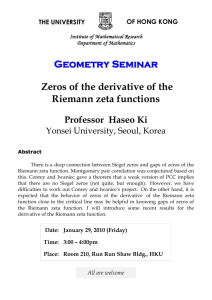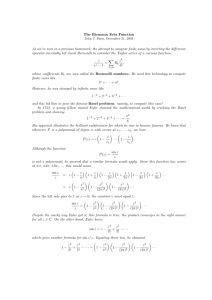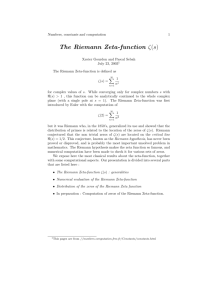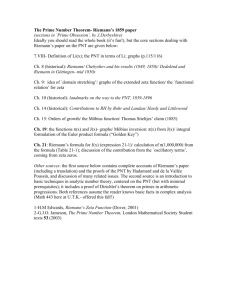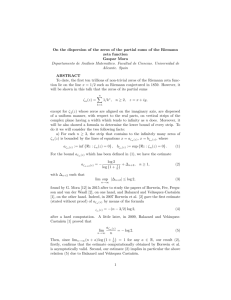Distribution of the Zeros of the Riemann Zeta Function Hugh L
advertisement
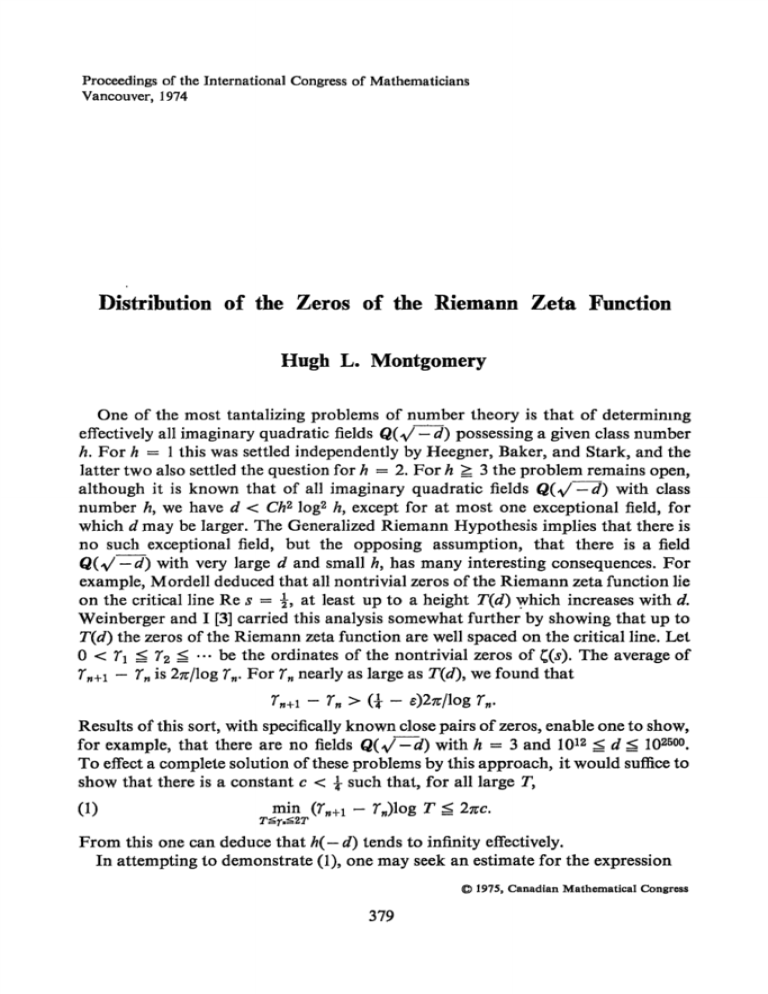
Proceedings of the International Congress of Mathematicians
Vancouver, 1974
Distribution of the Zeros of the Riemann Zeta Function
Hugh L. Montgomery
One of the most tantalizing problems of number theory is that of determining
effectively all imaginary quadratic fields Q(^/ — d) possessing a given class number
h. For h = 1 this was settled independently by Heegner, Baker, and Stark, and the
latter two also settled the question for h — 2. For h ^ 3 the problem remains open,
although it is known that of all imaginary quadratic fields Q(*J — d) with class
number h, we have d < Ch2 log2 h, except for at most one exceptional field, for
which d may be larger. The Generalized Riemann Hypothesis implies that there is
no such exceptional field, but the opposing assumption, that there is a field
Q(\/ — d) with very large d and small h9 has many interesting consequences. For
example, Mordell deduced that all nontrivial zeros of the Riemann zeta function lie
on the critical line Re s = | , at least up to a height T(d) which increases with d.
Weinberger and I [3] carried this analysis somewhat further by showing that up to
T(d) the zeros of the Riemann zeta function are well spaced on the critical line. Let
0 < Vi g ï2 ^ ••• be the ordinates of the nontrivial zeros of ^(s). The average of
?n+i — Tn i s 2rc/log T„. For Tn nearly as large as T(d)9 we found that
r w+1 - rn > a - e)27r/iog rn.
Results of this sort, with specifically known close pairs of zeros, enable one to show,
for example, that there are no fields Qi^d)
with h = 3 and 1012 g d ^ 102500.
To effect a complete solution of these problems by this approach, it would suffice to
show that there is a constant c < \ such that, for all large T9
(1)
min (rw+i - r„)log T £ 2%c.
From this one can deduce that h(— d) tends to infinity effectively.
In attempting to demonstrate (1), one may seek an estimate for the expression
© 1975, Canadian Mathematical Congress
379
380
(2)
HUGH L. MONTGOMERY
D(a,ß) =
2
lì
2xa/logTer-r'k27cß/logT
here 7 and 7' run independently over ordinates of nontrivial zeros of Q(s). Taking
Fourier transforms, we see that estimating the density D(a9 ß) is essentially a matter
of evaluating the form function
F(a) = (-£- log rV 1
2
T^r-f) w(r - V)
for real a, where w(u) = 4/(4 -f w2). Since Fis symmetric in 7 and 7*', we see that F
is real and even. Recently I showed [2] that if the Riemann Hypothesis is true then
Fis nearly nonnegative, F(a) ^ — e uniformly in a9 for T > TQ(e)9 and that
(3)
F{a) = (1 + o(\))T-i« log T + a + o(l)
for 0 ^ a ^ 1. For a > 1 the behavior changes, and we conjecture that
(4)
F(a) = 1 + o(l)
for a ^ 1. This conjecture is based on number-theoretic heuristics ; it implies that
(5)
D(a9 ß) ~ (J (l - ( ^ J ) du + ö(a,ß)) ~
log T
for eachfixeda < ß. Here d(a, jS) = 1 if 0 e [a9 ß], and 5(a, ß) = 0 otherwise. The
occurrence of the Dirac 5-function here is to be expected, for if a ^ 0 ^ ß then the
sum (2) includes terms with 7 = 7'. We note that our conjecture (5) implies (1) for
all c> 0.
It is interesting to note that the pair correlation function 1 — ((sin %u)/%uf9 which
occurs in (5), also arises as the limiting pair correlation of eigenvalues of random
Hermitian matrices of large order [1]. This is in accord with the view, originally
propounded by Pólya, that the Riemann Hypothesis might be proved by exhibiting
a Hermitian operator whose eigenvalues are related to the zeros of the zeta function. Indeed, it would probably be difficult to interpret (5) in a different framework.
Since (5) remains unproved, it is useful to note that, subject to the Riemann
Hypothesis, the estimate (3) enables one to evaluate asymptotically the sum
E
r{(7 - 7')^T-)w(7
- 7')
provided that the spectrum of r is sufficiently small. For example, we find that
o<r*T7i<r>£T\ \(7 - 7")log T )
3 2TT ë
From this we can show, still assuming RH, that at least 2/3 of the zeros of lj(s)
are simple, as follows. Let mp be the multiplicity of the zero p = \ -f- i7. In the
above sum there are m2p paris 7, 7' for which 7 = 7' = Im p, so that
S
o<r^T
***(•£ + « i ) ) £ i o g r .
ZEROS OF THE RIEMANN ZETA FUNCTION
381
On the other hand, we know classically that
S
Mp~J-logT.
Thus, combining these estimates,
£
1£ £
0<r^T\p simple
(Kj-êT
mp{2-mp)^(\+o{\))^-\ogT.
r
r
\J
/ 1%
Upon examination it will be seen that the above argument is not as efficient as it
might be. To obtain a sharp result, one is led to an extremal problem in which we
seek r e Ll(R) with r(u) ^ 0. We want
-foo
f(a) = J r(u)e-Zmaudu
—OO
to have support contained in [— 1, 1], and we want
(^m +
2\ar(a)da)/]r(a)da
to be minimal. M. E. Taylor and I have recently addressed ourselves to this problem,
and under the reasonable assumption that r(a) is of the form f(a) = h(a)*h(—a)9
we found that
h(a) = cos 2i /2 (a - \)
= 0
for |a| g 1,
otherwise,
yields the extremal function r. This leads to the result that, subject to the Riemann
Hypothesis, at least 3/2 - 2~ 1/2 cot 2" 1/2 = 0.6725--- of the zeros of the zeta
function are simple.
References
1. M. L. Mehta, Random matrices and the statistical theory of energy levels, Academic Press,
New York, 1967. MR 36 #3553.
2. H. L. Montgomery, The pair correlation of zeros of the zeta function, Proc. Sympos. Pure
Math., vol. 24, Amer. Math. Soc, Providence, R.I., 1973, pp. 181-193.
3. H. L. Montgomery and P. J. Weinberger, Notes on small class numbers, Acta Arith. 24(1974),
329-342.
UNIVERSITY OF MICHIGAN
ANN ARBOR, MICHIGAN 48104, U.S.A.

